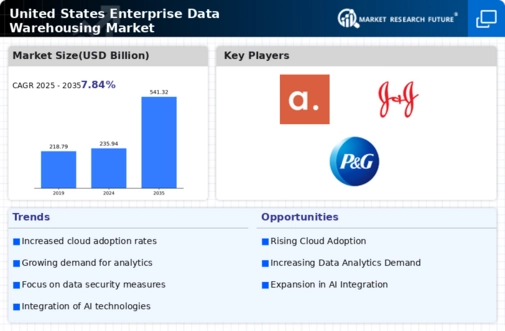Integration of Advanced Analytics Tools
The integration of advanced analytics tools into the enterprise data-warehouse market is transforming how organizations analyze and interpret data. Businesses are increasingly adopting machine learning and artificial intelligence technologies to enhance their analytical capabilities. This trend is indicative of a broader shift towards predictive analytics, which allows companies to anticipate market trends and customer behaviors. The enterprise data-warehouse market is projected to reach a valuation of $50 billion by 2026, driven by the growing need for sophisticated analytics solutions. As organizations seek to unlock deeper insights from their data, the integration of these advanced tools becomes essential for maintaining a competitive edge.
Regulatory Compliance and Data Security
In the enterprise data-warehouse market, regulatory compliance and data security are paramount concerns for organizations. With the increasing number of data protection regulations, such as the CCPA and GDPR, businesses are compelled to ensure that their data management practices align with legal requirements. This has led to a heightened focus on data governance and security measures within data warehouses. Companies are investing in robust security frameworks to protect sensitive information, which in turn drives growth in the enterprise data-warehouse market. It is estimated that organizations will allocate over $10 billion annually towards compliance and security solutions, underscoring the critical role these factors play in shaping market dynamics.
Rise of Hybrid and Multi-Cloud Environments
The enterprise data-warehouse market is experiencing a significant shift towards hybrid and multi-cloud environments. Organizations are increasingly adopting these models to enhance flexibility and scalability in their data management strategies. By leveraging multiple cloud platforms, businesses can optimize costs and improve performance while ensuring data accessibility. This trend is expected to contribute to a significant portion of the market's growth, with projections indicating that hybrid cloud solutions could account for over 40% of the enterprise data-warehouse market by 2027. As companies seek to balance on-premises and cloud resources, the demand for integrated data warehousing solutions continues to rise.
Increased Focus on Data Quality and Integrity
The enterprise data-warehouse market is placing greater emphasis on data quality and integrity as organizations recognize the importance of accurate data for decision-making. Poor data quality can lead to misguided strategies and lost opportunities, prompting businesses to invest in data cleansing and validation processes. This focus on data integrity is driving the adoption of advanced data management tools within the enterprise data-warehouse market. It is estimated that organizations will spend approximately $5 billion annually on data quality initiatives, reflecting a growing awareness of the need for reliable data. As companies strive to enhance their data governance frameworks, the emphasis on quality and integrity will likely shape the future landscape of the market.
Growing Demand for Data-Driven Decision Making
The enterprise data-warehouse market is experiencing a surge in demand as organizations increasingly recognize the value of data-driven decision making. Companies are leveraging data warehouses to consolidate vast amounts of data from disparate sources, enabling them to derive actionable insights. According to recent estimates, the market is projected to grow at a CAGR of approximately 12% over the next five years. This growth is fueled by the need for businesses to enhance operational efficiency and improve customer experiences. As organizations strive to remain competitive, the enterprise data-warehouse market becomes a critical component in their strategic initiatives, allowing them to harness the power of data effectively.














Leave a Comment